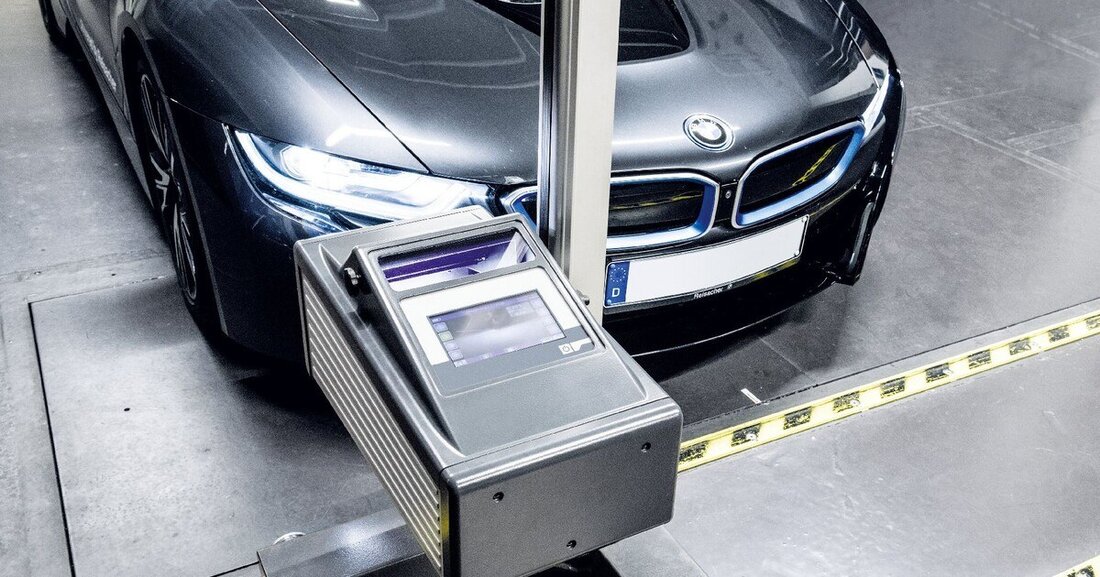Headlights: The question of attitude
When it comes to correctly adjusting modern high-tech headlights, workshops have to invest more and more effort.

Headlights: The question of attitude
Xenon headlights once made the hitherto classic halogen headlights look quite old and weak. Within just a few years, xenon burners have established themselves on the market. Adjusting the halogen and xenon headlights was also quite simple. Anyone who has the space could and still can use the “10 meter wall” method to check and adjust the headlights. However, since many workshops do not have the space for this, headlight setting devices that simulate the 10 meter wall method soon became popular for testing and adjustment. They reduce the space required to 50 centimeters in front of the headlights and can be used in many places - in theory. In order to be able to test and adjust a headlight correctly, the headlight setting location must meet a precisely defined requirement, the DIN ISO standard 10604. This primarily concerns sizes and dimensions, but the most important thing is the inclination tolerance, i.e. how uneven the test surface for the headlight setting device (SEG) can be. The simplified rule of thumb: With a length of four meters (minimum length for car tests), the deviation may only be 10 millimeters.
Headlight positioning positions must be precisely leveled in order to obtain an acceptable test position, but it does not always have to be a structural measure in order to achieve the goal. If the workshop floor is outside the tolerance, you can help yourself with three measures (also in combination). On the one hand, with leveling surfaces. These drive-up elements, which can be installed later, can be adjusted precisely and individually in order to achieve the exact level. The alternative to this are platforms that have level control. Such platforms can of course be used more universally, for example for wheel alignment or calibration of driving assistance systems. The third option is level-compensating adjustment devices (self-leveling), which can compensate for unevenness of up to around four percent and thus compensate for structural inaccuracies. Although these devices are often significantly more expensive than standard models, they can save you from having to level the floor afterwards.
Is an analog SEG enough for me, or do I need a digital one? Paul Lindenthaler, expert for diagnostics and headlight adjustment devices at workshop supplier Siems & Klein: "Due to the blue fringe in xenon light, the eye is not able to determine the exact light-dark boundary. The exact assessment and adjustment of the headlights required for safe road traffic can no longer be carried out with an analog SEG." Even with the relatively new matrix light, you reach the limit with analogue devices: “With matrix headlights, the light adjustment only works sensibly with a digital device.” An analogue setting of these headlights is theoretically possible with a lot of effort, but is not accepted by many manufacturers. In addition, the process is very error-prone. In short: If you buy a device now, you should choose a digital SEG. The reason: Active headlight systems are moving further and further from the upper vehicle classes towards the middle class. Depending on the active headlight model, the corresponding diagnostic devices must also be attached to the vehicle for correct adjustment in order to run test cycles precisely defined by the vehicle manufacturer. The tolerance values are 0.5 percent of the target value. In these systems, the subsurface level, SEG and diagnostic device work closely together; otherwise a precise result is no longer possible. For independent workshops, this means: If you want maximum compatibility with your tools, you have to dig significantly deeper into your pockets. While analogue SEGs are available for several hundred euros, digital high-end headlight aiming devices can quickly cost several thousand euros. But you then have devices that no longer have to be afraid of any vehicle, no matter how new and expensive. Interesting note from Siems & Klein expert Lindenthaler: "The SEGs from HGS & MAHA can now be updated via USB or WiFi. However, subscriptions are necessary to keep up with all the innovations in lighting technology."
If you have a leveling solution for your removed headlight position and know which SEG you want to work with, there is still one question: Should the headlight leveling device run on rails or on normal wheels? There are two approaches to this: Rail systems can be adjusted even more precisely and quickly than models on wheels, unless your own floor is correspondingly flat. In addition, unevenness can be compensated for using a rail system, which means you can avoid complex floor work. There are also rail systems that can be driven over, with which a cleverly planned test lane can be easily driven through. Another plus of the rail solution: changing sides from one headlight to the other is quicker and more accurate than having to reposition the device manually each time. You save a lot of time throughout the year and have fewer sources of error when aligning. Paul Lindenthaler from Siems & Klein added: “The leveling rail system is the optimal alternative to costly workshop conversions.” Quickly assembled and readjustable at any time, the rail system impresses with its long service life and attractive price.

 Suche
Suche
 Mein Konto
Mein Konto